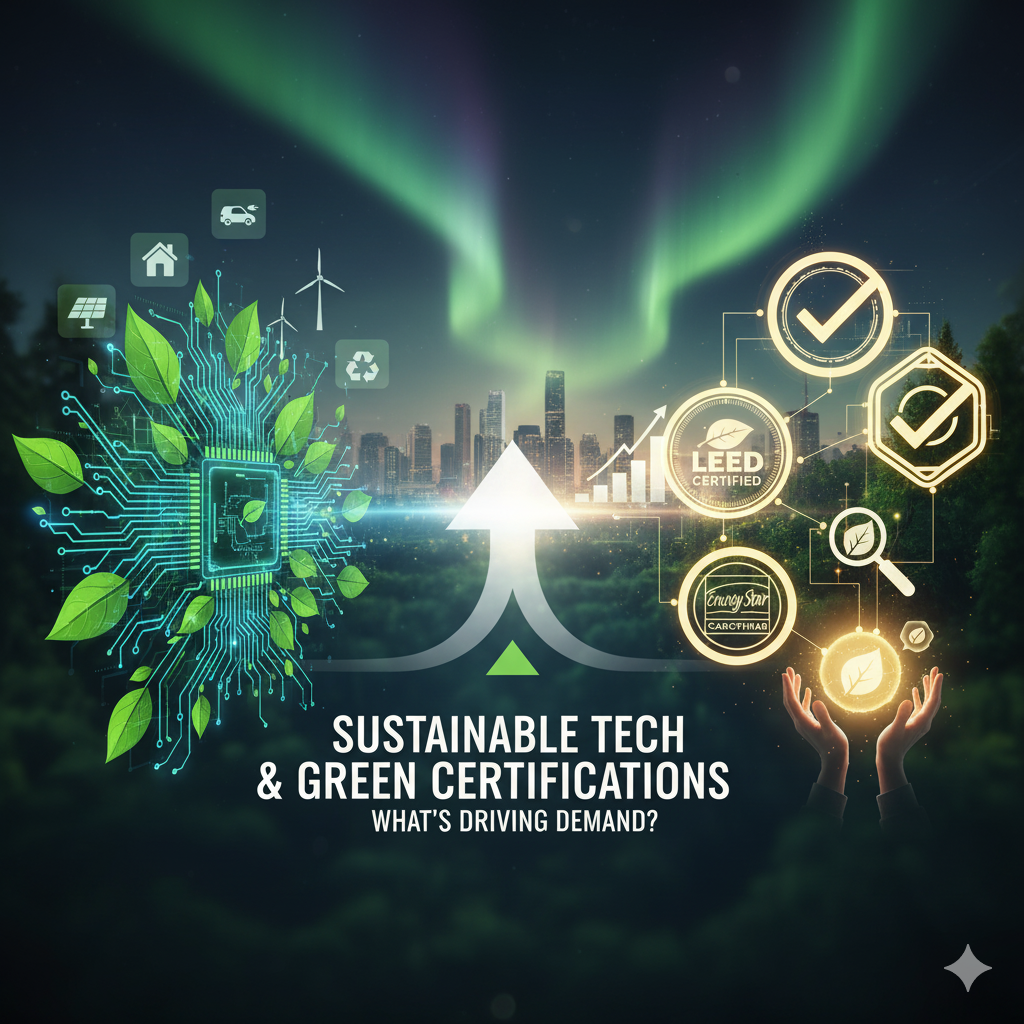
Sustainable Tech & Green Certifications: What's Driving Demand?
The clamour for sustainable technology and green certifications isn't just a trend; it's a monumental shift transforming the global economy. What's powering this acceleration? A potent mix of environmental pressure, stricter regulations, consumer conscience, and the rise of a new corporate mantra: ESG (Environmental, Social, and Governance).
The global green technology and sustainability market is exploding, projected to reach nearly $80 billion by 2030—a clear signal that sustainability is now a core business imperative, not an afterthought.
1. The Power of the ESG Mandate
For years, corporate success was measured primarily by profit. Today, a new metric dictates long-term viability: ESG performance. Investors are pouring capital into companies with strong ESG profiles, seeing them as less risky and more future-proof.
E (Environmental): Focuses on a company's impact on nature, including carbon emissions, energy efficiency, waste management, and resource depletion.
S (Social): Looks at relationships with employees, suppliers, customers, and communities (e.g., labour practices, diversity, human rights).
G (Governance): Deals with a company's leadership, executive pay, audits, internal controls, and shareholder rights.
The ESG-Tech Feedback Loop: Strong ESG ratings are proven to enhance green technology innovation. This creates a feedback loop: companies invest in green tech (like AI for energy optimization or sustainable supply chain platforms) to improve their ESG score, which in turn attracts more investment and talent.
💡 Real-Life Case Study (Outsourced Green Tech): A major European logistics firm, aiming to hit net-zero targets, outsourced the development and management of a proprietary AI-driven route optimization platform. This platform, using real-time data, cuts fuel consumption and emissions by predicting the most efficient delivery routes, contributing directly to their E-score. The outsourced solution provided specialized AI and cloud expertise that the firm lacked internally, showcasing how outsourcing accelerates complex green technology adoption.
2. Regulation and the Race to Compliance 📜
Governments worldwide are transforming climate commitments into non-negotiable legal requirements. These regulations are a powerful catalyst for the adoption of certified green technologies.
Carbon Pricing & Reporting: Policies like carbon taxes and mandatory emissions reporting (e.g., the EU's Corporate Sustainability Reporting Directive - CSRD) force businesses to quantify and disclose their environmental impact. This drives immediate demand for sustainability platforms—software solutions that use IoT and AI to monitor, measure, and report ESG metrics accurately.
Green Building Standards: Increased mandates for energy-efficient buildings (e.g., LEED or BREEAM certifications) drive demand for certified sustainable materials, smart energy management systems, and specialized infrastructure. The green building sector remains a dominant application area for sustainable technology.
3. The New Green Ecosystem: Tech & CertificationsThe growing demand for green technology solutions is most evident where resource efficiency meets regulatory compliance, forging a new green ecosystem underpinned by technology and certifications. This ecosystem leverages AI & Analytics for process optimization, enabling applications like predictive maintenance and energy grid balancing, while IoT (Internet of Things) facilitates real-time monitoring through smart city sensors and precision agriculture. Furthermore, Circular Economy Tech drives waste reduction and resource efficiency via advanced recycling and product lifecycle management, and Cloud Computing supports the decarbonization of IT as hyperscalers commit to powering their data centers with 100% renewable energy.
Green Certifications: The Trust Currency Certifications (like ISO 14001 for environmental management or Energy Star for product efficiency) provide credibility and transparency. They act as a trust currency for consumers and regulators, proving a company’s claims are verified, not just "greenwashing." This is why demand for certified sustainable products is on the rise.
4. The Expanding Green Job Market 🧑💻
The demand for sustainable technology is creating a massive new job market. The shift to a green economy requires a significant upskilling and a new set of professional roles.
-
Explosive Job Growth: Projections suggest a significant surge in green jobs globally by 2030, in roles ranging from Sustainability Analysts and Carbon Accounting Specialists to Renewable Energy Engineers and Green Data Scientists.
-
The Skills Gap: Currently, the demand for professionals with certified green skills far outstrips supply, leading to a scramble for green talent. This is fueling the need for specialized outsourced services and new green certification programs to rapidly train the workforce.
Internal Link: Are you looking to pivot your career? Explore our article on the https://chronolearn.net/blog
Conclusion
The demand for sustainable tech and green certifications is not driven by a single factor but by an unstoppable convergence:
-
The Ecosystem: Global climate crisis and resource scarcity.
-
Regulation: Stricter governmental mandates and reporting laws.
-
ESG: Investor and stakeholder pressure for transparent, responsible corporate behaviour.
-
Opportunity: The multi-billion dollar market and the creation of millions of new green jobs.
In this new reality, investing in sustainable technology and verifiable certifications is no longer a choice—it's the only viable path for future business success and global responsibility.






